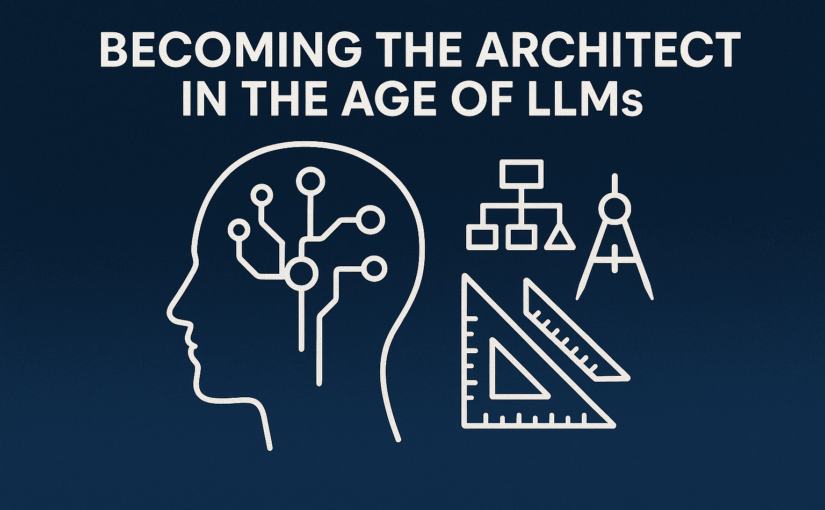If your value ends at syntax, AI already replaced you.
Let’s get something straight:
If you think of LLMs as “copilots,” you’re still giving them too much credit.
They’re not copilots.
They’re autopilot systems — ruthlessly fast, dangerously obedient, and totally unaware of what matters.
Feed them incomplete specs, fuzzy goals, or mismatched priorities?
They won’t challenge you.
They won’t hesitate.
They’ll execute — confidently, fluently — exactly the wrong thing.
They don’t know your business.
They don’t know your constraints.
They don’t know what not to build.
What’s missing isn’t syntax.
It’s ownership. Intent. Engineering judgment.
And unless you provide it —
you’re not flying the plane.
You’re luggage and replacable with AI.
Part I: Automation Always Eats the Bottom
This has happened before. Every decade. Every role.
- Punch card operators (1950s–1960s): Once essential for running programs. Replaced by terminals and interactive computing. By the mid-‘70s, gone.
- Typists & secretarial pools (1960s–1980s): Entire floors dedicated to document production. WordPerfect, then Microsoft Word, ended that. By the early ‘90s, obsolete.
- Sysadmins (1990s–2010s): SSH into boxes, hand-edit configs, restart crashed daemons. Then came Puppet, Chef, Ansible, Terraform… Cloud abstractions finished the job. The manual server “ssh”-based work. Retired.
- Manual QA testers (2000s–2010s): Clicking through forms, comparing results by eye. Replaced by Selenium, Cypress, and CI pipelines. QA is now design-driven. The button-clicker job didn’t survive.
Every wave started the same way:
The job wasn’t eliminated.
The repetitive part of it was.
If you couldn’t rise above the routine — you were gone.
Now it’s happening to developers.
Not the ones architecting resilient, auditable systems.
The ones chaining together plugin-generated CRUD and calling it “done.”
LLMs are just the latest wave. But it moves very fast …
And here’s the reality:
- A carpenter refusing to use a circular saw isn’t defending craftsmanship — they’re bottlenecking it.
- But give that saw to someone with no skill, and they’ll still ruin the wood — just faster — If you currently see many post of non-coders who “vibe”-code there stuff, that’s what I am talking about here. ;-)
Same with LLMs.
They don’t replace skill.
They amplify whatever’s already there — good or garbage.
LLMs aren’t replacing software engineers.
They’re replacing the illusion that the bottleneck was ever syntax or tools.
Part II: Complexity Wasn’t Removed. It Was Repositioned.
There’s a dangerous myth floating around that LLMs “simplify software development.”
They don’t.
They just move the complexity upstream — away from syntax, into strategy.
LLMs are great at building what you ask for.
But they’re terrible at knowing if what you asked for actually makes sense.
They don’t understand:
-
They don’t understand the business.
-
They don’t understand tradeoffs.
-
They don’t understand you.
They just build. Fast.
And that means your job as a developer is no longer about typing — it’s about thinking upstream.
Because the real work now is:
-
Framing prompts like functional specs
-
Embedding constraints into system design
-
Validating output against business goals
-
Catching side effects before they cascade
None of that lives in syntax.
It lives in system boundaries, architecture, and clear thinking.
So here’s the shift:
If your job is just to write the code — you’ll be replaced by the thing that does that faster.
But if your job is to design the system — you’re now more critical than ever.
Part III: The ELIZA Effect Isn’t Dead — But LLMs Are Waking Up
In 1966, Joseph Weizenbaum built one of the first “AI” programs: ELIZA.
It wasn’t smart.
It didn’t understand anything.
It just rephrased your input using simple pattern matching.
You: I’m feeling anxious.
ELIZA: Why do you say you’re feeling anxious?
It used tricks — not intelligence.
But people still believed in it. Some even refused to accept it was a machine.
That’s the ELIZA Effect:
Our instinct to see intelligence where there’s only mimicry.
Fast-forward to today.
LLMs don’t just mimic. They generate.
They write code. Plan modules. Suggest architectural patterns.
But here’s the risk:
We still project too much intelligence into the output.
When an LLM writes a function that looks correct, we tend to assume it is correct — because it sounds confident.
When it uses a pattern, we assume it understands the context.
But it doesn’t.
And that’s not its fault — it’s ours.
The real danger isn’t hallucination.
It’s over-trusting surface-level coherence.
Today, it’s not a chatbot fooling a user.
It’s a system generator fooling a team.
But let’s be clear: Modern LLMs aren’t ELIZA anymore.
They can plan. Refactor. Respond to constraints. Incorporate feedback.
The difference is this:
ELIZA tricked you into thinking it was smart.
LLMs require you to be smart — to guide them properly.
If you bring judgment, context, and validation to the loop, LLMs become an architectural power tool.
But if you don’t? You’ll scale the same flawed design — just faster.
Part IV: Code Quality Is Becoming a Mirage
LLMs make it absurdly easy to generate code.
A few prompts, and boom:
Endpoints scaffolded.
Unit tests written.
CRUD flows spinning up in seconds.
But here’s the real question:
What do you do with all that saved time?
Do you…
-
Refactor legacy architecture?
-
Fix broken boundaries?
-
Document edge cases and invariants?
Or do you just move on to the next ticket?
Let’s be honest — for most teams, the answer is: ship more.
But here’s the catch:
Productivity without reflection is just accelerated entropy.
The illusion of quality isn’t in the code — it’s in the pace.
We used to write bad code slowly.
Now we write bad code faster.
LLMs don’t inject tech debt.
They just make it easier to scale whatever process you already have.
This is how LLMs become quiet killers in modern software:
-
More output. Less ownership.
-
Faster shipping. Sloppier systems.
-
Progress that isn’t progress at all.
Because without validation, speed is just a prettier form of chaos.
Part V: The Architect Is the Pilot
LLMs are not copilots.
They don’t make decisions.
They don’t check alignment.
They don’t steer the system.
They’re autopilot — optimized for syntax, blind to strategy.
Which means your role isn’t shrinking — it’s elevating.
You’re the pilot.
And if you’re not flying the plane — someone else is programming it to crash.
What does the real pilot do?
-
Sets the course
-
Defines the constraints
-
Monitors the signals
-
Prepares for failure
-
Owns the outcome
Autopilot builds. But it can’t see.
It won’t:
-
Catch abstraction leaks
-
Detect architectural drift
-
Flag a misaligned dependency
-
Or recognize when a “working” feature breaks the user journey
That’s your job.
Not “prompt engineering.”
Not code generation.
Systems thinking.
And not in hindsight — up front.
The modern software engineer isn’t typing faster.
They’re designing better.
And validating deeper.
Because LLMs don’t ship systems.
People do.
And if you can’t explain how your choices align with product, people, and long-term stability?
Then you’re not the architect.
You’re just the operator.
Conclusion: Stop Writing Code. Start Owning Systems.
If your job was just to “write the code,” then yes — that part is already being done for you.
But if your job is to engineer the system — with intent, constraints, validation, foresight, and grounded execution —
then you just became irreplaceable.
LLMs don’t remove the need for developers.
They reveal who was actually doing engineering — and who was just typing faster than the intern.
The future of software isn’t syntax.
It’s systems thinking. Boundary design. Constraint management. Communication at scale.
And that’s not generated.
That’s your job.
TL;DR
-
LLMs are autopilot, not copilots. They follow, they don’t lead.
-
They move complexity upstream. The value is no longer in typing.
-
They amplify output — good or bad. Skill is still required.
-
They don’t replace good engineers. They replace bad workflows.
-
System thinking is the new baseline. If you’re not owning structure, you’re already behind.

